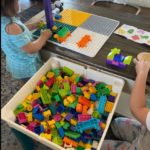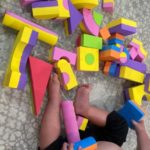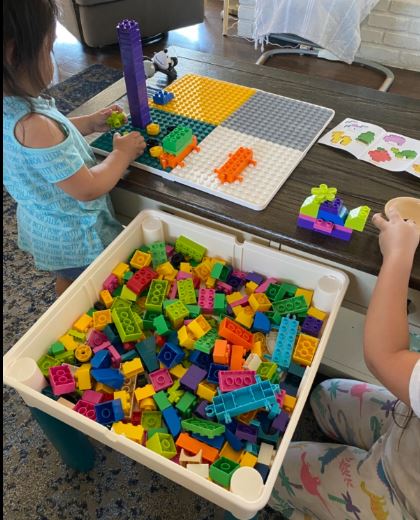Many parents or teachers (likely you, reading this article!) have children that are either in preschool or on their way to preschool. They all think about what games, or activities are best for their child’s learning. Blocks are often a popular choice, rightfully so, for a wide variety of reasons! What are the best types of blocks for preschoolers though?
 Why are Building Blocks a Good Toy for Preschoolers?
Why are Building Blocks a Good Toy for Preschoolers?
Building blocks are one of the best toys to have in your home and in your play area. These simple yet multi-functional toys are great for expanding language, communication and sharing with others. Additionally, their ideal for fine motor development, counting and problem solving! Let’s talk about why different types of building blocks are good for preschoolers!
Fine Motor Development
When kids are playing with blocks whether they are big or small, hard or squishy, they are engaging their fine motor skills. This occurs when they grab the blocks, stack them on top of each other, next to one another, etc.
Some popular ways to enhance fine motor development would be to create race tracks or stack a tall tower!
Counting
When stacking blocks up to make a tower or even to build a street to push a toy car on, this can lead to some counting lessons! For example, asking your preschooler how many rectangle blocks do they need? How many red squares? Playing with blocks can even lead to peer-play development! For example, responding to friends asking for a specific number of blocks, then that preschooler responding and learning how many three actually means.
Problem Solving
Problem solving is a natural key component to any play, but with building blocks this occurs when they are stuck on what to do next. They may need to consider what blocks they need that will fit the creation they are making or even how to ask for help form their teachers or friends.
What are the Different Types of Blocks for Preschoolers?
The different types of blocks that are available to play with seems almost never ending; Duplos and Legos, wooden blocks, magnetic blocks, foam blocks, are just a few, and the list goes on! What are the different type sof blocks for preschoolers and what makes them all so unique?
Legos and Duplos
Legos are those blocks that have the circles on top and the open bottoms that allow for them to be stuck together, they can come in the tiniest pieces to attach to a large flat “plate” and stack until you have a village of Legos!
Duplos are the larger blocks that have the same idea of stacking on top of each other, but are more aimed for tower building and shape making with all the different shapes they come in.
Wooden Blocks
The most standard building block that comes from way back when, in all different shapes and sizes, are wooden blocks. They are great for building fortresses and allow for great imaginative play.
Magnet Blocks
Magnets in these plastic blocks keep them from falling apart easily and make the coolest towers. They are even some magnet blocks that are built with wheels to make cars to drive the blocks around!
Foam Blocks
These are squishy and soft blocks that can also stack up like wooden or hard blocks. They come in all different shapes and sizes. They are a little squishy and soft, so that helps with fine motor with preschoolers, making it easier to grab the building blocks.
What Should be in a Preschool Block Play Area?
 The most important pieces are the blocks, all different shapes, sizes, colors and textures. For example, Legos and Duplos, foam blocks, magnet blocks, etc. You will also need some cubbies or boxes to place the blocks in when they are not in use. Make sure each kind of block has its own storage area so nothing gets mixed up! It can also be beneficial to have a carpet area for designating where preschoolers can build. This keeps things organized and the blocks in one specific area.
The most important pieces are the blocks, all different shapes, sizes, colors and textures. For example, Legos and Duplos, foam blocks, magnet blocks, etc. You will also need some cubbies or boxes to place the blocks in when they are not in use. Make sure each kind of block has its own storage area so nothing gets mixed up! It can also be beneficial to have a carpet area for designating where preschoolers can build. This keeps things organized and the blocks in one specific area.
Consider having a few bins of “extras” for kids to incorporate into their block play. For example, some farm animals, dinosaurs, toy cars, even toy people area great!
What are the Stages of Block Play?
There are roughly seven stages of Block Play that build on the previous stage and are important for development among preschoolers.
Stage 1: Carrying and Exploring
You’ll see in this stage an infant or toddler is holding their blocks and transferring them from one area or even container to the next, over and over again.
Stage 2: Stacking Rows or Towers
The beginning of stacking towers up high or across the floor in a line is around 2 to 3 years old. This is when they start learning how to use those fine motor skills.
Stage 3: Bridges and Passageways
Between the ages of 3 and 4, preschoolers start stacking their blocks and learning how to balance them between 2 other blocks to make a bridge or tower.
Stage 4: Enclosure
In this stage their imagination starts to take off, their towers become houses or buildings by enclosing them and taking up more space in their learning area.
Stage 5: Symmetry and Patterns
Children will realize all the different “accessories” they can add to their building and begin to incorporate them into their play.
Stage 6: Functional and Naming of Structures
Between the ages of 4 and 5, preschoolers will now begin to label their buildings, towers, bridges, etc. and even pretend play begins as well, racing cars down the track, helicopter flying through the city, etc.
Stage 7: Complex and Symbolic
Age 5 and up, preschoolers starting to recreate buildings or places they have seen around or making their building more complex and intricate.
How Do You Encourage Playing with Blocks?
Encourage kiddos to play with blocks can be challenging is its just not a toy they love. There are however ways to help encourage this play. Having the blocks in front of you and having your preschooler knock them over is always a great method. Kids love to watch things fall down and then help you stack them back up.
Final Thoughts
We hope this post on types of blocks for preschoolers was a help! Building blocks for preschoolers are essential toys that help establish so many crucial learning developments. Kids play while enhancing fine motor, matching, problem solving and creativity skills! They encourage sharing with friends on top of it and of course language and communication starts to grow as well!

